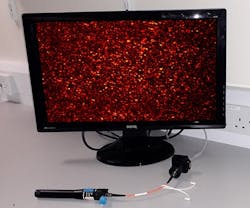Imaging fiber-optic speckle enables low-cost, attometer-precision wavelength meter
A team of researchers from the University of St Andrews (St Andrews, Scotland) has achieved a breakthrough in the measurement of lasers that they say could revolutionize the future of fiber-optic communications. They also say the wavelength meter (or wavemeter) will boost optical and quantum sensing technology, enhance the performance of next-generation sensors, and expand the information-carrying capacity of fiber-optic networks.
Led by professor Kishan Dholakia from the School of Physics and Astronomy, the team passed laser light through a short length of optical fiber, which scrambles the light into a grainy pattern known as 'speckle'. As described in Optics Letters, the shape of the speckle pattern changes with the wavelength of the laser and can be recorded on a digital camera.
The team used the speckle pattern to measure the wavelength at a precision of an attometer. This is around one thousandth of the size of an individual electron and 100 times more precise than previously demonstrated. For context, the measurement of such small changes in the laser wavelength is the equivalent to measuring the length of a football pitch with an accuracy equivalent to the size of one atom.
Wavemeters are used in many areas of science to identify the wavelength of light. All atoms and molecules absorb light at very precise laser wavelengths, so the ability to identify and manipulate wavelength at high resolution is important in diverse fields ranging from cooling of individual atoms to temperatures colder than the depths of outer space, to the identification of biological and chemical samples. The ability to distinguish between different wavelengths of light also allows more information to be sent through fiber-optic communications networks by encoding different data channels with different wavelengths.
Conventional wavemeters analyze changes in wavelength using delicate, high-precision optical components. The cheapest instruments used in most everyday research cost tens of thousands of dollars. In contrast, the St Andrews wavemeter consists of only a 20 cm length of optical fiber and a camera. In the future it may be made even smaller.
Dholakia explains, "The principle of the wavemeter can be easily demonstrated at home. If you shine a laser pointer on a rough surface like a painted wall, or through a semi-transparent material like frosted sellotape, the laser gets scrambled into the grainy speckle pattern. If you move the laser, or change any of its properties, the exact pattern you see will change dramatically. It's this sensitivity to change that makes speckle a good choice for measuring wavelength."
In the future, the team hopes to demonstrate the use of quantum technology applications in space and on Earth, as well as to measure light scattering for biomedical studies in a new, inexpensive way.
SOURCE: University of St Andrews; https://news.st-andrews.ac.uk/archive/dont-adjust-your-sets-new-research-could-revolutionise-fiber-optic-communications/
About the Author

Gail Overton
Senior Editor (2004-2020)
Gail has more than 30 years of engineering, marketing, product management, and editorial experience in the photonics and optical communications industry. Before joining the staff at Laser Focus World in 2004, she held many product management and product marketing roles in the fiber-optics industry, most notably at Hughes (El Segundo, CA), GTE Labs (Waltham, MA), Corning (Corning, NY), Photon Kinetics (Beaverton, OR), and Newport Corporation (Irvine, CA). During her marketing career, Gail published articles in WDM Solutions and Sensors magazine and traveled internationally to conduct product and sales training. Gail received her BS degree in physics, with an emphasis in optics, from San Diego State University in San Diego, CA in May 1986.
